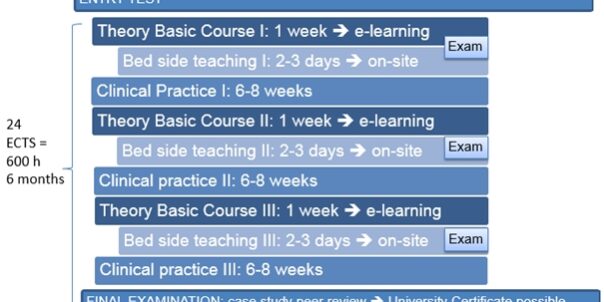Healing chronic wounds is part of the challenges clinicians are confronted with in their daily routine.
Introducing standardized treatment concepts and guidelines have shown to improve healing rates, reduce healing time and decrease treatment costs.
The target of our holistic concept is to improve quality of treatment, increase efficacy and efficiency and as a result give the patients a better quality of life.
In the course we offer treatment pathways for chronic wounds, which were developed by European medical professionals according to European guidelines.
In the educational program the fundamental knowledge to conduct these pathways will be taught, furthermore the student will get deepening knowledge about wound healing mechanisms, underlying diseases and various indications based on scientific outcome.
Learning targets
In the university course “Wound and Disease management” the student learns about the basics in wound and wound treatment.
The goal is to create a common understanding and knowledge about wounds, their underlying diseases and a holistic view of the patient.
The student learns the latest evidence based treatment therapies and gets trained to understand and follow treatment pathways for chronic wounds in combination with documenting, controlling and critically re-evaluating these treatment strategies.
Competence
- The student will be able to critically reflect his knowledge about wounds and from this basis he/she broadens his/her knowledge and is able to implement it in practice;
- the student learns to critically reflect his/her abilities in systemic and topical wound treatment, if necessary to correct and learn improved ways of treatment;
- the student learns about latest scientific findings giving new solutions for treatment of patients with wounds.
Academic Certificate
The graduation certificate will be a European University Certificate which gives the graduate the title “Wound and Disease Manager”.
National accreditation and job profile according to legal requirements has to be adapted for each country where the program is introduced with our network partners.
Entrance Criterias:
Candidates with the following pre-requisites are qualified to apply for the admission procedure:
- Completed university studies in medicine or nursing science
or Diploma in nursing science
- plus 2 years practice in healthcare sector as nurse/doctor and
- proof that the candidate is working with wound patients
Admission:
Beside the formal criteria, which will be checked by the academic partner, the student has to make an entry test.
The student has to prepare some topics from Basic Course I and needs to prepare a multiple-choice test.
Tuition fees
The cost structure and the determination of the fee are depending on national structures and network partners. Included are: National and international trainers, access to our e – learning platform, access to a special wound documentation system, tutoring, study material, samples, seminar room and technical equipment.
Not included: travel costs, accommodation costs
Workload and mode of studies:
The focus of the university course Wound and Disease Management will be on practice time and long distance learning.
The theoretical weeks Basic Course I + II + III are on e-learning basis and self-study.
The student becomes, after admission to the course, access to the e-campus.
Concerning the workload, we are following the European Credit Transfer System.
1 ECTS point equals 25h workload for the student.
The course is structured in 3 modules with each 8 ECTS points, which is divided in 50% self-study, 30% practice time and 20% bedside teaching and case report preparations.
| Outline of online contents |
| Anatomy and Physiology of the Wound: •The Skin – Anatomy and Physiology •The Vascular system – Anatomy & Physiology •Basics in Microbiology and Hygiene |
| Pathophysiology of the Wound: •Basics in Wound Healing •Wound Infection •Wound Cleansing and Debridement •Classification of Dressing Material, Handling and Dressing Changes |
| Diagnosis, Treatment Therapy and Documentation I: •Wound Photography and Wound Documentation •Treatment Pathways:Venous leg ulcer, Arterial leg ulcer, Diabetic foot syndrome, Pressure ulcer |
| Compression Therapy I |
| Negative Pressure Wound Therapy I – Introduction and Basics |
| Influence factors in wound healing: •Pain Management I •Nutrition and Chronic Wound Patients I |
| Diagnosis, Treatment Therapy and Documentation II: •Stagnant Wounds •Surgical Wound Closure •Negative Pressure Wound Therapy II – Advanced •Palliative Therapy of Wounds •Differential Diagnosis in Chronic Wounds |
| Infectiology: •Basics in Infectiology •MRSA Eradication •Cleansing Effect |
Language of teaching is English.
For more information about the program and the next course dates, please contact office@ihm.ac.at or use our contact form
http://ihm.ac.at







